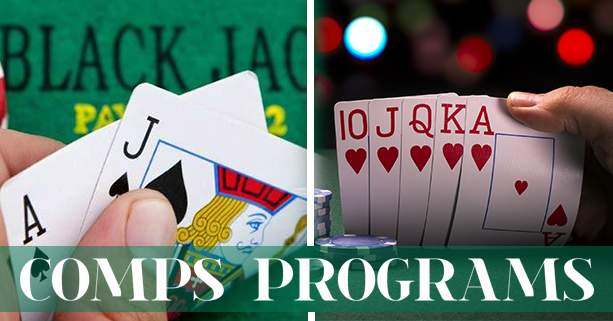Casino regulars love nothing more than winning big and beating the house – but scoring comps comes in at a close second.
Short for “complimentary,” comps are the freebies doled out by every casino to help customers alleviate recent losses. Sure, you might have just blown through a few hundred bucks at the blackjack table, but when you’re handed a free buffet voucher, the loss stings just a little bit less.
Casinos use a carefully designed system to distribute comps, but even veteran players can have trouble understanding exactly how that system works. And that’s definitely by design.
Most players simply assume that their players club card allows their play to be tracked, allowing the casino to assign points over time. And while that’s a rough outline of how it all goes down, the actual calculations are far more complicated.
The situation gets even messier when you factor in different game types. Slot players earn comps at a different rate than table game fans, for example, and folks who prefer poker have an entirely different set of rules to work with. Knowing your way around this maze of math formulas is the best way to ensure that your play produces the maximum amount of comp points.
To that end, I’ve put this page together to explain exactly how comp programs differ for two of the most popular games on the floor – blackjack and poker.
Overview of the Major Comp Programs
Before we dive into the intricacies of blackjack and poker comps, I thought it might be a good idea to take a quick crash course on comp programs.
Thanks to the corporate conglomeration that has dominated the casino industry in recent years, most gamblers have two major comp programs to choose from – M Life and Total Rewards.
The M Life program is operated by MGM Resorts International, while Total Rewards is a product of Caesars Entertainment.
If you enjoy visiting sunny Las Vegas for a stroll along the Strip, chances are good you’ll wind up in a casino owned by one of these behemoths. And I’m not talking about the MGM Grand or Caesars Palace flagship properties, as the two companies own dozens of casinos between them.
Check out the list below for a full accounting of MGM-owned properties on the Strip where the M Life card is used to track and distribute comps:
- ARIA Las Vegas
- Bellagio Las Vegas
- Excalibur Hotel and Casino
- Luxor Las Vegas
- Mandalay Bay Resort and Casino
- MGM Grand Las Vegas
- The Mirage Las Vegas
- Monte Carlo Resort and Casino
- New York New York Hotel and Casino
And below, you’ll find the Caesars-owned casinos on the Strip where the Total Rewards card is accepted:
- Bally’s Las Vegas
- Caesars Palace
- The Cromwell Las Vegas
- Flamingo Las Vegas
- Harrah’s Las Vegas
- The LINQ Las Vegas
- Paris Las Vegas
- Planet Hollywood Las Vegas
- Rio All Suite Hotel & Casino
Expanding the scope outside of Sin City, these are the MGM-brand casinos worldwide where M Life membership is accepted:
- Beau Rivage – (Biloxi, Mississippi)
- Borgata – (Atlantic City, New Jersey)
- The Water Club – (Atlantic City, New Jersey)
- Gold Strike Casino Resort – (Tunica Resorts, Mississippi)
- Grand Victoria – (Elgin, Illinois)
- MGM Grand Detroit – (Detroit, Michigan)
- MGM National Harbor – (National Harbor, Maryland)
- MGM Springfield – (Springfield, Massachusetts)
- MGM Grand Sanya – (Sanya, Hainan, China)
- MGM Macau – (Macau, China)
- Bellagio Shanghai – (Shanghai, China)
And finally, take a look below for the full list of Caesars-owned casinos worldwide where Total Rewards membership is accepted:
|
|
Along with these titans of the gambling industry, you’ll also come across a few smaller casino chains like Boyd Gaming or Stations. And of course, the over 400 tribal casinos operated on reservation land nationwide have their own in-house players club cards.
These smaller casinos tend to model their comp system after the big boys, however, so I’ll stick with M Life and Total Rewards going forward for the sake of clarity.
For both of these programs, you’ll also have two main forms of comp credits to work with – base points and tier points.
A base point equates to $0.01, so you’ll need to score 100 of them to add $1 to your comp account. Base points effectively serve as cash in an affiliated casino, so you can use your accumulated points to purchase that morning latte or some headphones from the gift shop.
A tier point doesn’t have cash value per se, but these points are how you climb through the ranks of either M Life or Total Rewards. You can visit the overview pages for each program that I linked to above to learn about the various tiers used in each. But put simply, accumulating tier points grants you access to a higher tier in the program, which in turn unlocks additional perks. Think priority access at the cashier’s cage line, free valet and parking, tickets to the in-house show, and even free rooms.
Now that you know who is handling your comps and where the players club cards in your wallet are accepted, let’s see exactly how they work for both blackjack and poker.
How Comps Are Distributed to Blackjack Players
So, you’ve sidled up to a standard blackjack table, slid your M Life or Total Rewards card to the dealer, and watched them scan it through to the system. Now what?
Well, that’s a mystery many blackjack enthusiasts are still trying to crack.
The Total Rewards website spells things out quite clearly for slots and video poker:
But when you scroll down in search of table games like blackjack, the numbers aren’t nearly as clear – and in fact, Total Rewards doesn’t provide any concrete numbers at all:
Reward Credits are earned based on length of play, average bet and type of game.”
As you can see, Caesars Entertainment properties use a proprietary formula – based on how long you play, your average wager amount, and the type of table game played – to determine how many comp points you’ll earn. Obviously, this leaves quite a bit of wiggle room for the casino, while players never really know for sure how their blackjack session is being parlayed into points.
It’s even murkier over on the M Life website, which only provides the following information for table game players:
M Life Rewards members must satisfy minimum betting requirements to be rated for table games.
Please see a table games pit supervisor at participating M Life Rewards destinations for such assistance.”
In this case, playing at an MGM Resorts property leaves you at the whim of a table games pit boss, along with an unknown minimum betting requirement.
Thankfully, the internet levels the playing field tremendously, and you’ll find plenty of blackjack forums and travel sites where players can discuss their own comp experiences. By perusing a few of these platforms, I’ve been able to come up with the following figures.
Whether you’re using the M Life or Total Rewards card, you’ll need to bet an average of $25 per hand just to get your play “rated” by the casino. For most recreational gamblers who bet the minimum of $5, or $10 when they’re feeling lucky, that threshold alone prices them out of the comp program.
But let’s say you pony up the dough and bet a green $25 chip on each hand (on average). Now, the next factor to consider is your hands per hour rate. Most industry estimates peg the average blackjack table at 80 hands per hour, so I’ll go with that.
If you’re betting $25 per hand and playing 80 hands per hour, you’ll have $2,000 in total bets on the table over that span.
The next calculation the casinos use involves their theoretical hold rate, or the number of dollars they can expect to win based on the game’s house edge. Depending on your skill level, blackjack offers a house edge between 0.50% (for basic strategy experts) and 1.5% (for folks playing by “gut instinct” alone). Knowing this, I’ll use a flat 1% house edge to make the math easier.
Having bet $2,000 in total over the hour, while facing a house edge of 1%, the casino’s theoretical hold stands at $20.
From there, you can expect to receive comp points equal to 10% of the hold, which comes to just $2 in this example.
That was for one hour of play only, while most of us tend to stick around the tables for a few hours at a time. But for a general rule of thumb, assume you’re earning about $1 in comp points for every $1,000 you put at risk in a 60-minute period.
The big problem most blackjack players encounter is improper ratings by the pit boss. It’s their job to closely observe the action, entering your typical betting unit and your time at the table into the system. But if the pit boss sees you starting out at $10 bets to warm up, before you start firing the green chips, you might not ever get rated at all.
On the other hand, you might get your rating set at $25 bets from the outset, only to up the ante when you’re on a heater. At this point, you could be betting $50 or $100 per hand, all while the system continues to track you as a $25 bettor.
For this reason, blackjack players who value comp points should always take measures to clarify their play to the pit boss. That’s their job, after all, so you’re not bothering anybody by asking for a quick chat. Just let them know your name, that you’ve had your card scanned, and your plan for the game.
Something like “Hi there, I’m so-and-so, and I’ll be betting $25 and up for the next hour or two” should be sufficient. And if you decide to increase the stakes midway through the session, just give the dealer a glance and let them know to alert the pit boss about the new wager.
This can all seem like a chore at first, especially for casual gamblers, but it’s the only ironclad way to ensure that your blackjack play is properly rated.
How Comps Are Distributed to Poker Players
For this discussion, I’ll be focusing on the cash game and tournament poker played between one another – and not video poker machines.
If you are interested in the video poker comp formula, however, you’ll get one base point on both M Life and Total Rewards for every $10 in wagers. Given the fast pace of play on video poker, and slots for that matter, most comp-chasers tend to stick to the machines to maximize their value.
As for traditional poker played at a table, the system is a little different. You’ll slide your players club card to the dealer like you did at the blackjack table, and they’ll press a button to begin your session tracking. When you get up and leave, they’ll press the button once more to alert they system that your session has ended.
Unlike the blackjack tracking program, poker player comps aren’t based on your betting habits. That’s because games like Texas hold’em and pot limit Omaha are highly variable, meaning you’ll be folding and betting nothing on many hands before betting big bucks when you find a monster hand. Knowing this, the casinos base your comp rate on the table stakes.
For the Total Rewards program, poker players sitting at the smallest No Limit Texas hold’em table – $1 small blind and $2 big blind stakes – will earn 17 Tier Credits per hour. Additionally, $1/$2 players will receive 100 Reward Points – Total Rewards’ name for base points – which comes out to $1 for every hour played.
When you up the ante to $2/$5 blinds and higher, the Tier Credits allotment doubles to 34 per hour. You’ll still get the same 100 Reward Points per hour, however, so jumping up in stakes is really only good for reaching a new tier in the program.
If you’re an M Life loyalist, the poker situation seems to be a bit more fluid.
As of now, each of the various poker rooms operating within an MGM Resorts casino is free to use their own system.
The ARIA on the Strip, for example, is one of the most popular poker rooms on the planet – and players there earn $2 worth of base points for every hour played. And that rate doesn’t change depending on the blinds, either.
But head across the street to the MGM Grand, and you’ll get $1 worth of base points for every hour played at a $1/$2 table. Move up to $2/$5 or higher, and the comps double to $2 in base points.
That $2 per hour rate looks like it’s fairly standard, with the Bellagio and the Mirage both using the same figure – but always be sure to check before playing a hand.
I like to take advantage of a resource known as Poker Atlas, which compiles information on every poker room in North America. You can check out the Poker Atlas page for the ARIA here to get a feel for the site. Just do a CTRL+F search for “comps,” and you’ll find the latest figures made available.
And to help get you started, check out the table below for a full rundown of poker rooms in Las Vegas – including those that don’t fall under the M Life or Total Rewards umbrella. The table was compiled by poker pro Ashley Adams for PokerNews, and it also includes the maximum rake taken out of each pot:
| Casino | Maximum Rake | Comps Per Hour |
| ARIA | $4 | $2 |
| Bally’s | $5 | $1 |
| Bellagio | $4 | $2 |
| Binion’s | $4 | $2 |
| Boulder Station | $4 | $1 |
| Caesars | $4 | $2 |
| Cannery | $4 | $1 |
| Club Fortune | $3 | $1 |
| Excalibur | $4 | $2 |
| Flamingo | $5 | $1 |
| Golden Nugget | $4 | $2 |
| Green Valley Ranch | $4 | $1 |
| Harrah’s | $4 | $1 |
| Luxor | $4 | $2 |
| Mandalay Bay | $4 | $1 |
| MGM | $5 | $1 |
| Mirage | $4 | $2 |
| Orleans | $3 | $1.25 |
| Palace Station | $4 | $1 |
| Planet Hollywood | $5 | $1 |
| Red Rock Casino | $4 | $1 |
| Sam’s Town | $3 | $1.25 |
| Santa Fe Station | $4 | $1 |
| Silver Sevens | $4 | $1 |
| South Point | $4 | $1 |
| Sun Coast | $3 | $1.25 |
| Stratosphere | $4 | $1 |
| Venetian | $5 | $1 |
| Wynn | $5 | $1.50 |
Comps for poker players don’t end at points, however. If you’re a serious player who puts in extended sessions, you can score discounted room rates for the duration of your stay. These are known as “poker rates,” and in the case of the ARIA, you’ll need to lodge five hours of play per day to qualify for the reduced rate.
As always, though, be sure to check in with the floor staff before sitting down to sort through a particular venue’s poker rate.
Finally, if you enjoy playing tournaments a la the World Series of Poker (WSOP) – which is owned and operated by Caesars Entertainment – you’ll earn Reward Points based on the size of the event’s buy-in. This policy was rolled out in 2012, with the WSOP replacing its usual food vouchers by linking your tournament play to the Total Rewards card.
At the time, WSOP Executive Director Ty Stewart had this to say about rewarding tournament players with points rather than vouchers:
We are thrilled the WSOP will help launch a company initiative to allow poker players to better unlock the power of the industry’s best loyalty program.
With nearly 40 properties worldwide and the number one tournament series in the world, we hope to give more players more opportunities to earn, and redeem for whatever is important to them.”
Here’s how it works. The low-level $1,000 tournaments produce $3 worth of Reward Points, while a $1,500 event jumps up to $4.50 worth of points. Play a $2,000 buy-in tournament to earn $6 in points, $2,500 for $7.50 in points, $3,000 for $9 in points, or $5,000 for $15 in points.
And if you play the $10,000 WSOP Main Event, you’ll score $30 back in points.
Conclusion
Whether you prefer doubling down at the blackjack table or doubling up in a poker game, maximizing your comp rewards is a smart move. This is essentially free money back based on your play, which always helps when you’re trying to beat the house. In fact, the savviest of players out there know how to earn full rebates on a losing session simply by exploiting the comp system. Take time to learn about how comps work at your casino of choice, and your bottom line will be better off in the long run.

 MENU
MENU















